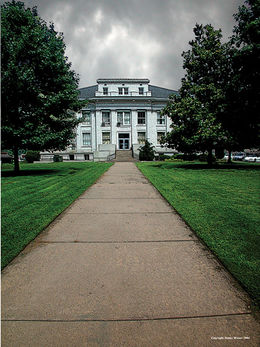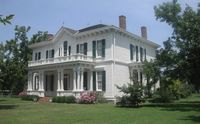New Madrid, Missouri
 From Conservapedia
From Conservapedia 
New Madrid is the county seat and largest community of New Madrid County, Missouri, which is named for it. It had a population of 3,116 at the 2010 census.
One of the oldest settlements in Missouri, New Madrid was founded as a port on the Mississippi River in the late 18th century. It is famous for the New Madrid earthquakes of 1811-12, which were centered in the area nearby.
Contents
- 1 History
- 2 Geography
- 3 Demographics
- 4 Education
- 5 Points of Interest
- 6 References
History[edit]
New Madrid's history as a permanent settlement dates back to the early 1780s, when Francois and Joseph LeSieur, two French-Canadian brothers and traders, traveled down the Mississippi to establish a trading post. They selected a spot on high ground near the point where St. John's Bayou emptied into the river, which made a great northward loop there. As this was one of the few elevated points overlooking the river south of its confluence with the Ohio, it had the potential to dominate trade in the lower Mississippi Valley. The LeSieur's named their trading post "L'Anse a la Graise" (Grease Creek), which may have been a reference to the abundance of bears (known for the greasiness of their meat and fat) in the area.[1]
In 1788 the entire region was awarded by a Spanish land grant to Colonel George Morgan, a Revolutionary War veteran from New Jersey who had proposed establishing a new town on the site of the trading post and attracting American as well as French, Spanish, and Indian colonists to build it up. Morgan took possession of the town in early 1789 and renamed it New Madrid, in an effort to curry favor with the Spanish government. (For unclear reasons, the pronunciation of "Madrid" was altered over time, with emphasis laid on the first rather than the second syllable and a short "a" sound [as in "apple"] taking precedence.)
However, the Spanish authorities distrusted Morgan and removed him in 1789, imposing an official commandant for New Madrid and the surrounding area. The town grew slowly in the next few years, populated first by French settlers from farther north, and later by American settlers from east of the Mississippi, especially after the Louisiana Purchase in 1803.
The most notable event in the early history of New Madrid was the string of earthquakes that occurred between December 1811 and February 1812, which bear its name. Though the first quakes had only a limited effect, their epicenter being well to the south, the tremor of February 7 (an estimated 7.5 to 8.0 on the Richter scale) struck much closer to town and practically destroyed it. Though loss of life was minimal, due to the low population and the fact that many had already fled, damage to existing structures was catastrophic, and the town languished until the late 1820s.[2]
Recovery was aided by New Madrid's selection as the county seat of New Madrid County in 1822, as well as by trade on the river and the clearing of the nearby area for farms and plantations. It was fairly prosperous by 1860, but then suffered severely from the effects of the Civil War. The region was mostly pro-Southern in sympathy, and early in the war, a Confederate force of some 7,000 was stationed in and around New Madrid to block Union movement down the Mississippi. Prior to the Battle of Island Number Ten (a Union victory), however, the city was taken by a Northern army under Major General John Pope on March 14, 1862, and would remain in Union hands for the rest of the war.[3]
After the war, New Madrid gradually recovered, owing to continued clearing of the land and the arrival of the railroad. By 1912, it counted some forty businesses, six churches, and (unlike many Southeast Missouri towns at the time) electric utilities. It has declined in size and prosperity in recent decades as a result of the mechanization of agriculture and the consequent reduction in job opportunities, though commerce and industry related to the Mississippi River traffic remains important.
Geography[edit]
New Madrid is located on the Mississippi River on the southeastern border of New Madrid County, along Interstate 55 and U.S. Routes 61 and 62. It faces south upon a large, northward oxbow bend of the Mississippi, known variously as Kentucky Bend or New Madrid Bend. This bend is so extreme that it cuts off a portion of Fulton County, Kentucky, which is only accessible by land from Tennessee to the south. Downtown New Madrid today lies slightly northeast of the original settlement, most of which eventually collapsed into the river due to erosion of the bank and the effects of the 1811-12 earthquakes.
The city's exact coordinates are 36°35’16”N 89°32’09”W. It has a total area of 4.53 square miles, and an average elevation of 295 feet.[4]
Like most of Southeast Missouri, New Madrid has a humid subtropical climate, characterized by hot summers, cool to mild winters, and frequently heavy rainfall. The average temperature is 34°F in January and 81°F in July, and the average precipitation is 49 inches. Heavy snow and extreme cold are uncommon.[5]
Demographics[edit]
At the 2010 census, New Madrid had a total of 3,116 inhabitants, grouped into 1,276 households, with a population density of 694.0 people per square mile. This figure represented a decrease from the 2000 census, when New Madrid had a population of 3,334. 72.30% of the inhabitants were White, 25.55% were African-American, 0.22% were Native American, 0.26% were Asian, 0.13% were from some other race, and 1.54% were from two or more races. Hispanics of any race were 0.80% of the population.
The median age in New Madrid was 39.8 years, with 24.1% of inhabitants under the age of 18, 7.8% between 18 and 24 years old, 23.6% between 25 and 44, 28.3% between 45 and 64, and 16.1% 65 years old or older. The sex ratio was 47.9% male, 52.1% female.[6]
According to the 2010 American Community Survey, the median household income in New Madrid was $28,542, and the median family income was $38,542. The unemployment rate was 7.0%. The per capita income was $22,129. About 24.3% of the population lived below the poverty line, including 27.7% of people under the age of 18 and 20.5% of people 65 years old or older.[7]
Education[edit]
Like most of the northern and central parts of the county, New Madrid is served by the New Madrid County R-I School District, which was formed in 1980 from the consolidation of the New Madrid district and several neighboring ones, including Lilbourn, Matthews, and Parma. The community itself is served by New Madrid Elementary, a PK-5 institution located in the city with an enrollment of about 300 students, and Central Middle (6-8) and High (9-12) Schools, which are on a combined campus just southwest of New Madrid in neighboring Howardville and have a total enrollment of about 700.[8]
The school's mascot is the Eagles, and its colors are green and gold. New Madrid County has an accomplished "Quiz Bowl" team and has made achievements in baseball, football, and basketball. On its official website, the school proudly describes itself as a place "...where students still recite the Pledge of Allegiance to the American flag every morning [and] where we still pray in the boardroom."[9]
Points of Interest[edit]

The most famous site in New Madrid is the Hunter-Dawson Home State Historic Site, located a short distance north of downtown near the intersection of First Street and Dawson Road. It was built by William Washington Hunter, who moved to the area from Virginia about 1830 and became a successful businessman, later building the antebellum mansion for his family (the "Dawson" derives from Hunter's son-in-law, William Dawson, who served in the House of Representatives in the 1880s). It was donated to the state as a historic site in 1967, and stands today as one of Missouri's best-preserved relics of the antebellum South.[10]
New Madrid also has several other homes dating to the 19th century, as well as an observation deck overlooking the Mississippi River.[11]
References[edit]
- ↑ https://collections.shsmo.org/manuscripts/ramsay/ramsay_new_madrid.html
- ↑ https://books.google.com/books?id=G-AlAAAAMAAJ&pg=PA1#v=onepage&q&f=false
- ↑ Larry J. Daniel and Lynn N. Bock, Island No. 10: Struggle for the Mississippi Valley. University of Alabama Press, 1996, p. 60-64.
- ↑ https://web.archive.org/web/20120125061959/http://www.census.gov/geo/www/gazetteer/files/Gaz_places_national.txt
- ↑ https://www.ncdc.noaa.gov/climatenormals/clim20/mo/236045.pdf
- ↑ https://factfinder.census.gov/faces/tableservices/jsf/pages/productview.xhtml?src=CF
- ↑ https://factfinder.census.gov/faces/tableservices/jsf/pages/productview.xhtml?src=CF
- ↑ https://www.greatschools.org/missouri/new-madrid/schools/
- ↑ https://www.nmceaglenation.com/about-us
- ↑ https://mostateparks.com/page/54972/general-information
- ↑ http://www.new-madrid.mo.us/31/Visiting
Categories: [Missouri Cities and Towns]
↧ Download as ZWI file | Last modified: 02/27/2023 10:35:05 | 18 views
☰ Source: https://www.conservapedia.com/New_Madrid,_Missouri | License: CC BY-SA 3.0
 ZWI signed:
ZWI signed: KSF
KSF